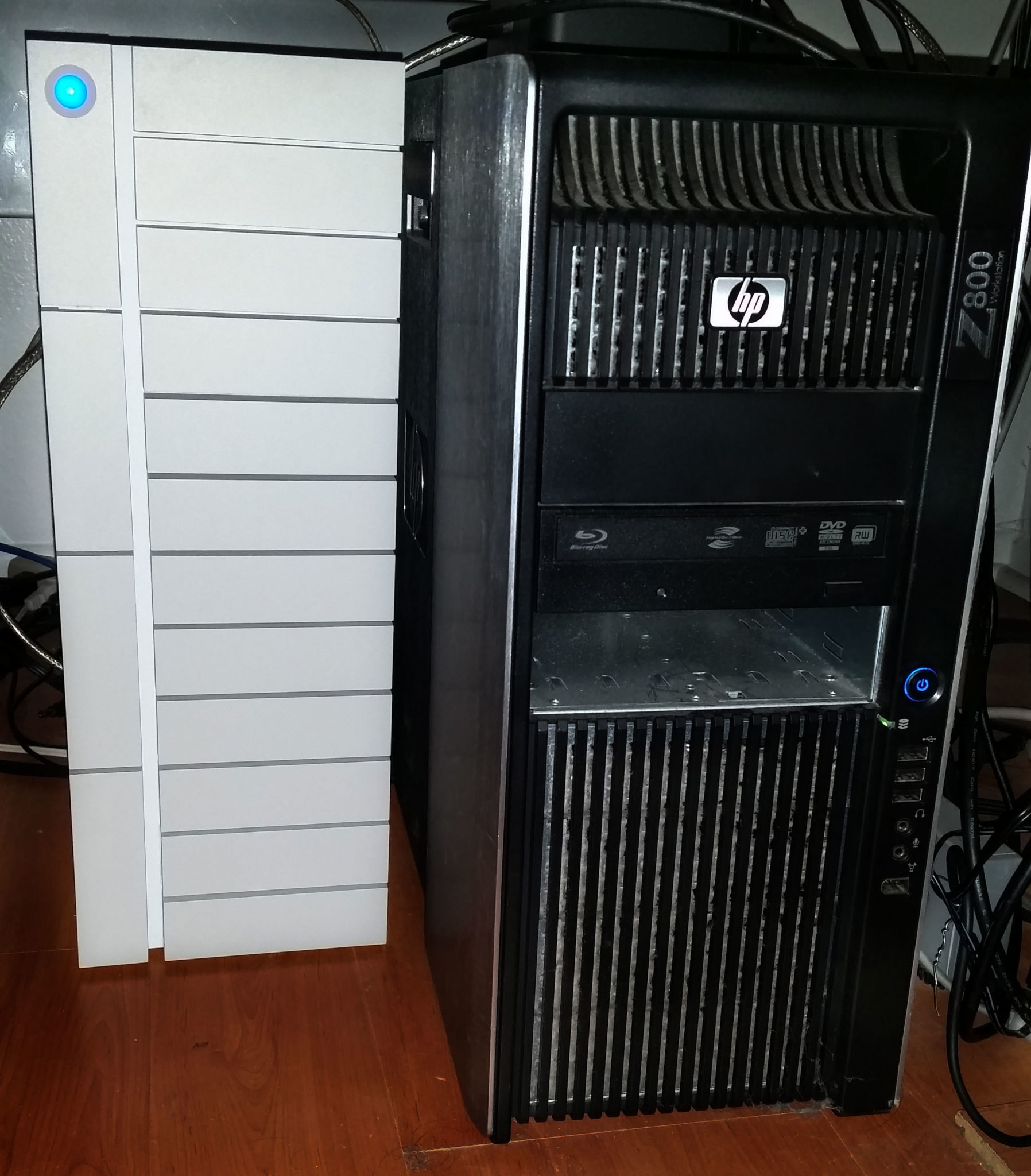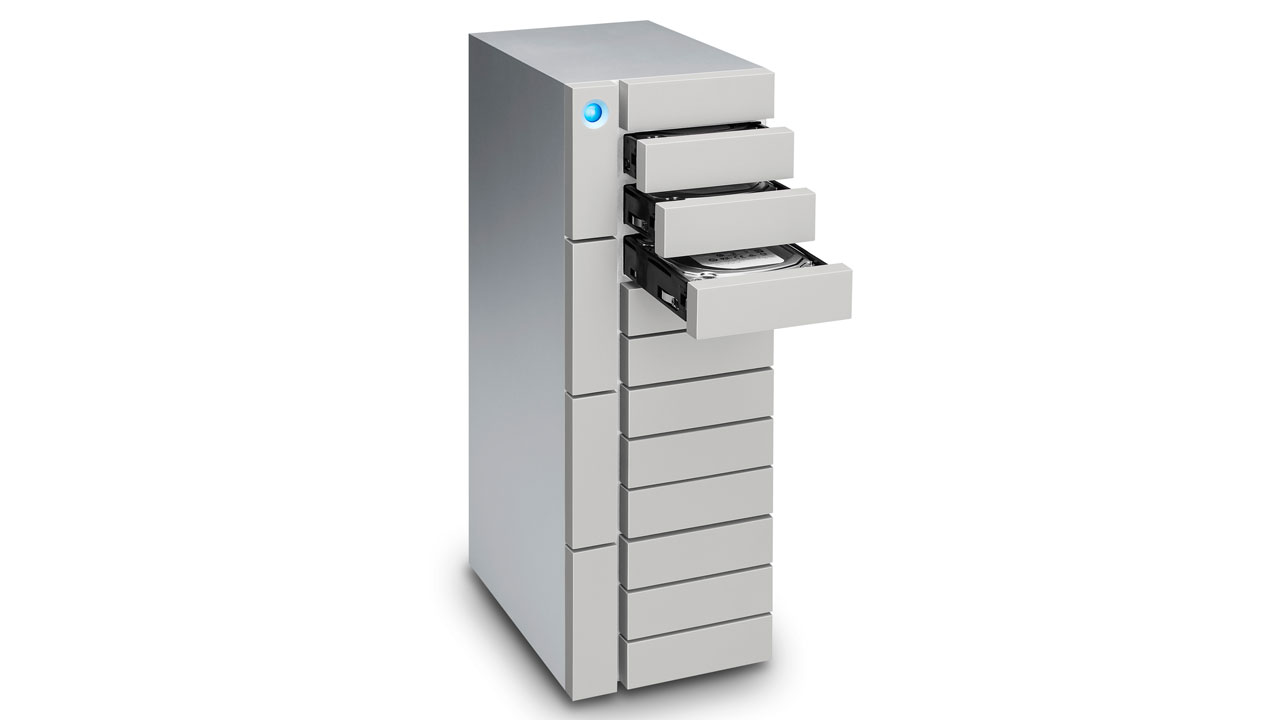
Marc Franklin
Just when you thought you had enough online hard disk space that you could edit your HD footage, you now have 4K+ ProRes files. The codec setting I use with my Blackmagic Design Ursa cinema camera gives you one minute of footage on 4GB of storage. An hour of footage takes up 240 GB. That means you need more than 2 TB for 10 hours of footage. And if you are editing, you will create preview files that require even more space — not to mention that you will need speed. If you just have a large drive, you may have the space, but not the speed.
A simple RAID 0 with two or more drives will increase the speed for editing and storage space. RAID 5 gives you speed, space and redundancy by using an algorithm to back up data if a drive goes bad. That’s why the LaCie “big” series uses 12 drives in the RAID 5 configuration: speed, space and reliability.
The LaCie 12big that I got for evaluation, the second-smallest model, was configured with 12 6 TB Seagate enterprise-class drives for a total of 72 TB raw. Formatting for RAID 5 brings that down to 66 TB. The 12big currently comes in 4 capacities (48 TB, 72 TB, 96 TB, and 120 TB) ranging in price from about $5,300 to $11,000, giving you a wide range of sizes and capacities to meet your size and budget requirements.
A Hefty Piece of Gear
The first thing I noticed is that the 12big is a large, heavy unit, weighing in at 39 pounds. If you have a bad back and you need to move it, ask for help or you will need a chiropractor. If you can lift it, then make sure you don’t knock anything with it, as the sharp edges will leave a gash. (Maybe LaCie can cover it with its signature orange rubber, like their rugged line of drives?) If you are planning to take it on set with you, use some sort of cart.
I set up the 12big with the HP Z1 G3 all-in-one workstation, which is the only system I had with a Thunderbolt 3 port. When you first attach the 12big to an edit system, you may need to run LaCie’s set-up software, which runs diagnostics, checks the drive for errors, and allows you to re-format it in other RAID configurations. The 12big came pre-formatted to RAID 5, and I recommend keeping the 12big as it comes out of the box; a full re-format could take weeks.
I decided to tackle an existing project with the 12big. My HP Z820 workstation with an internal 6 TB RAID 0 was having issues playing back a few streams at a time. I didn’t want to deal with making proxies, editing and reconnecting the original media, so I copied it to the 12big on the less-powerful Z1 workstation. The Z820 has two eight-core 2.4 GHz Xeon CPUs as well as an Nvidia P6000 GPU and 32 GB RAM, but no Thunderbolt 3 port. (There is a Thunderbolt 2 port, but it has never worked properly.) To edit with the 12big, I connected it to a newer HP Z1 with a single quad-core Xeon CPU and a mid-level Nvidia M2000 GPU — not exactly a speed demon compared to the Z820, but at least it has Thunderbolt 3.
Opening up the Premiere Pro CC project on the HP Z1 and 12big was quick. I didn’t notice any major lag time. There was a definite increase in playback performance, especially when using the multicam editing mode. Due to space restrictions in my home office I had to temporarily take apart the Z1 NLE, so I attached the 12big to my older HP Z800 system with a USB 3.1 (10 gbps) card in it. The 12big also worked very well with it. So if you are on the Windows OS and having issues with finding a Thunderbolt 3 equipped workstation, USB 3.1 can work with some speed compromises. But be advised that the LaCie 12big does not have a legacy Thunderbolt 2 port. As far as I could tell as of this writing, only Apple makes a bidirectional Thunderbolt-2/3 cable. It may be worth the $50 investment.
Not a NAS
Despite its huge capacity, the LaCie 12big should be considered a giant hard drive, not network attached storage (NAS). A NAS is generally a large-capacity RAID meant to be attached to a number of computers over a network, mainly for backing up projects. The 12big is not a NAS and is only meant to be hooked up to a single workstation at a time.
At the same time, the 12big is spacious enough that you could back up dozens of projects on several NLE workstations without coming close to filling it up. I had a bunch of old 8mm film laser-scanned to huge high-resolution files and stored on a hard drive by The Archivist. The only drive I had that was big enough to store it was a 4 TB LaCie Rugged RAID. It took more than half the capacity. I was able to transfer it all onto the 12big and it barely made a dent.
Recently, we had to tent my house for termites, so I took the 12big to my edit systems’ internal 6 TB RAID 0s and dumped all of the contents on it as a back up. Both systems didn’t use 10% of its capacity. Having that much capacity in a RAID 5 configuration is very comforting. That said, is the 12big for everyone? If you can afford it and need the speed, it is great.
In conclusion, if you are working on a feature film or TV show with a budget, the LaCie 12big RAIDs are what you need for reliable, fast online storage, configured to protect your data from faulty drives. If you are a smaller shop, and don’t need all the speed and space, there is another option. I haven’t personally tried it out, but I’m guessing a 6big may be what you need. If you can’t afford the hefty price of the 12big and could live with a little less speed, LaCie’s 6big RAIDs are also available with street prices starting at $2,700 for 24 TB and topping out at $5,500 for 60 TB. Tell LaCie to send one to me and I’ll happily put it through its paces.










